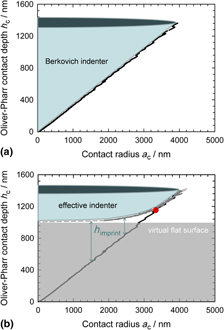Crossref Citations
This article has been cited by the following publications. This list is generated based on data provided by
Crossref.
Durst, Karsten
Rehman, Hamad ur
and
Merle, Benoit
2012.
Comment to paper “Penetration depth and tip radius dependence on the correction factor in nanoindentation measurements” by J.M. Meza et al. [J. Mater. Res. 23(3), 725 (2008)].
Journal of Materials Research,
Vol. 27,
Issue. 8,
p.
1205.
Maier, Verena
Merle, Benoit
Göken, Mathias
and
Durst, Karsten
2013.
An improved long-term nanoindentation creep testing approach for studying the local deformation processes in nanocrystalline metals at room and elevated temperatures.
Journal of Materials Research,
Vol. 28,
Issue. 9,
p.
1177.
Schmid, C.
Maier, V.
Schaufler, J.
Butz, B.
Spiecker, E.
Meier, S.
Göken, M.
and
Durst, K.
2013.
Highly resolved analysis of the chemistry and mechanical properties of an a-C:H coating system by nanoindentation and auger electron spectroscopy.
Thin Solid Films,
Vol. 528,
Issue. ,
p.
263.
Krottenthaler, M.
Schmid, C.
Schaufler, J.
Durst, K.
and
Göken, M.
2013.
A simple method for residual stress measurements in thin films by means of focused ion beam milling and digital image correlation.
Surface and Coatings Technology,
Vol. 215,
Issue. ,
p.
247.
Depner-Miller, U.
Ellermeier, J.
Scheerer, H.
Oechsner, M.
Bobzin, K.
Bagcivan, N.
Brögelmann, T.
Weiss, R.
Durst, K.
and
Schmid, C.
2013.
Influence of application technology on the erosion resistance of DLC coatings.
Surface and Coatings Technology,
Vol. 237,
Issue. ,
p.
284.
Göken, M.
2014.
Moderne Methoden der WerkstoffprüFung.
p.
299.
Fu, Guanghui
2014.
Effects of Assumed Pressure Distributions on the Fundamental Relation Used in Nanoindentation Data Analysis.
International Journal of Mechanical Engineering Education,
Vol. 42,
Issue. 1,
p.
30.
Haag, Fabian
Beitelschmidt, Denise
Eckert, Jürgen
and
Durst, Karsten
2014.
Influences of residual stresses on the serrated flow in bulk metallic glass under elastostatic four-point bending – A nanoindentation and atomic force microscopy study.
Acta Materialia,
Vol. 70,
Issue. ,
p.
188.
Malchow, P.
Johanns, K.E.
Möncke, D.
Korte-Kerzel, S.
Wondraczek, L.
and
Durst, K.
2015.
Composition and cooling-rate dependence of plastic deformation, densification, and cracking in sodium borosilicate glasses during pyramidal indentation.
Journal of Non-Crystalline Solids,
Vol. 419,
Issue. ,
p.
97.
Čech, Jaroslav
Haušild, Petr
Kovářík, Ondřej
and
Materna, Aleš
2016.
Examination of Berkovich indenter tip bluntness.
Materials & Design,
Vol. 109,
Issue. ,
p.
347.
Vierneusel, Bernd
Benker, Lisa
Tremmel, Stephan
Göken, Mathias
and
Merle, Benoit
2017.
Isolating the effect of residual stresses on coating wear by a mechanical stress relaxation technique.
Thin Solid Films,
Vol. 638,
Issue. ,
p.
159.
Zong, W.J.
Wu, D.
and
He, C.L.
2017.
Radius and angle determination of diamond Berkovich indenter.
Measurement,
Vol. 104,
Issue. ,
p.
243.
Merle, Benoit
Maier-Kiener, Verena
and
Pharr, George M.
2017.
Influence of modulus-to-hardness ratio and harmonic parameters on continuous stiffness measurement during nanoindentation.
Acta Materialia,
Vol. 134,
Issue. ,
p.
167.
Leitner, A.
Maier-Kiener, V.
and
Kiener, D.
2018.
Essential refinements of spherical nanoindentation protocols for the reliable determination of mechanical flow curves.
Materials & Design,
Vol. 146,
Issue. ,
p.
69.
Golovin, Yu. I.
Korenkov, V. V.
and
Razlivalova, S. S.
2018.
Effect of Low-Amplitude Load Oscillations on Stiffness and Hardness for Al and W in Loaded Nanocontacts.
Bulletin of the Russian Academy of Sciences: Physics,
Vol. 82,
Issue. 9,
p.
1180.
Malyar, Nataliya V.
Springer, Hauke
Wichert, Jürgen
Dehm, Gerhard
and
Kirchlechner, Christoph
2019.
Synthesis and mechanical testing of grain boundaries at the micro and sub-micro scale.
Materials Testing,
Vol. 61,
Issue. 1,
p.
5.
Merle, Benoit
Higgins, Wesley H.
and
Pharr, George M.
2020.
Extending the range of constant strain rate nanoindentation testing.
Journal of Materials Research,
Vol. 35,
Issue. 4,
p.
343.
Brazil, Owen
and
Pharr, George M.
2021.
Direct observation of partial interface slip in micrometre-scale single asperity contacts.
Tribology International,
Vol. 155,
Issue. ,
p.
106776.
Barjaktarević, Dragana
Međo, Bojan
Đokić, Veljko
and
Rakin, Marko
2022.
Current Problems in Experimental and Computational Engineering.
Vol. 323,
Issue. ,
p.
123.
Schaffar, Gerald J. K.
Kappacher, Johann
Tscharnuter, Daniel
and
Maier-Kiener, Verena
2022.
The Phase Transformation of Silicon Assessed by an Unloading Contact Pressure Approach.
JOM,
Vol. 74,
Issue. 6,
p.
2220.





